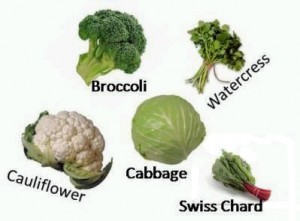Written by Dr. Sharliza Mohd. Saleh for Biomed Middle East
Eating fruits and vegetables are no doubt good for our body. Consumption of cruciferous vegetables specifically has recently been emphasised for its benefits as an anti-carcinogen. Cruciferous vegetables are those vegetables in the Cruciferae family such as Eruca (rocket), Raphanus (radish), Nasturtium (watercress) and Brassica (broccoli, brussels sprout, cabbage and cauliflower). They contained phytochemicals called glucosinolates.
Different types of cruciferous vegetables contained different glucosinolates, such as glucoraphanin and glucoiberin in broccoli and gluconapin and sinigrin in brussels sprout. Glucosinolates are hydrolysed to isothiocyanate by the action of chewing. Isothiocyanate is the active substance and is responsible for the many health benefits, which include anti-carcinogenic property
(1). Sulforaphane, an isothiocyanate, which are formed mainly from the Brassica group, exhibit anti-carcinogenic effect by inducing the phase 2 enzymes in human cells. Up regulating these enzymes promotes detoxification of metabolic products and help in reducing damages to macromolecules, which leads to the reduction of neoplastic changes in cells. Study carried out by Fahey et al
Epidemiological studies carried out also shows evidence that consumption of vegetables especially crucifers reduces the risk of colorectal cancer
Cruciferous vegetables consumption was also associated with the reduction in the risk of prostate cancer
(4). The case control study was done in the USA, participants who were recently diagnosed with prostate cancer were given questionnaire for their food consumptions 3-5 years before diagnosis. This study was carried our against control participants. Results showed that high consumption of vegetables in men with 28 or more servings of vegetables per week showed a 35% decreased risk of prostate cancer compared with those consuming less than 14 servings per week. Furthermore, consumptions of cruciferous vegetables of more than 3 serving per week reduces the risk of prostate cancer by 41% compared to consumption of less than 1 serving per week.
The evidence from consumption of cruciferous vegetables clearly shows its benefits as anti-carcinogen. We should be made aware of these special vegetables for us to benefit maximally.
By Dr Sharliza Mohd Salleh
References:
1. Albena T. Dinkova-Kostova. Lecture notes: Glucosinolates and Sulforaphane in Health and Disease. University of Surrey. 12th November 2008.
2. Fahey JW et al. Sulforaphane inhibits extracellular, intracellular and antibiotic-resistant strains of Helicobacter pylori and prevents benzo[a]pyrene-induced stomach tumors. Proceedings of the National Academy of Science of the USA.(2002) May 28; 99 (11):7610-5.
3. Vorrips et al. Vegetables and fruit consumption and risk of colon and rectal cancer in a prospective cohort study. American Journal of Epidemiology. (2000) Dec 1; 152 (11): 1081-92.
4. Cohen JH, Kristal AR, Stanford JL. Fruit and vegetable intakes and prostate cancer risk. Journal of the National Cancer Institute. (2000) Jan 5; 92 (1):61-8.
Cruciferous vegetables
Cruciferous vegetables. For a botanical description of plants in this family (whether or not used for food), see Brassicaceae. Ten of the most common vegetables eaten by people are in a single species (B. oleracea), and are not distinguished from one another taxonomically, but only by the horticultural category of cultivar groups. Numerous other genera and species in the family are also edible.
Cruciferous vegetables are one of the dominant food crops worldwide. Widely considered to be healthful foods, they are high in vitamin C and soluble fibre and contain multiple nutrients with potent anti-cancer properties: diindolylmethane, sulforaphane and selenium. Both diindolylmethane, sulforaphane, and many other sharp-tasting substances in these vegetables are produced from substances called glucosinolates.
